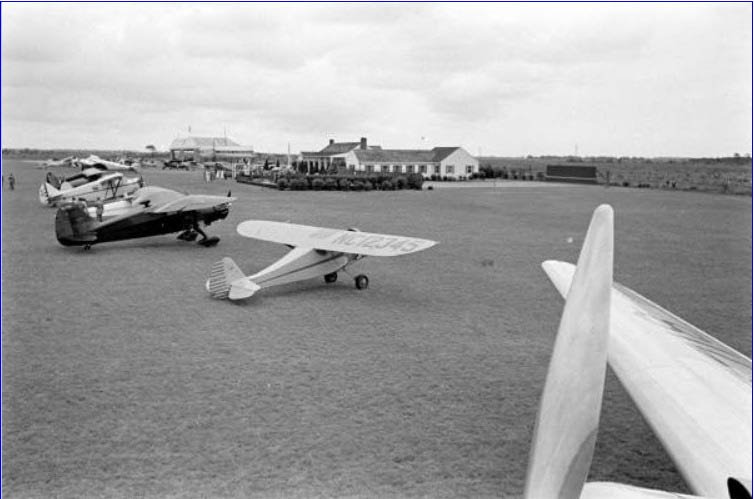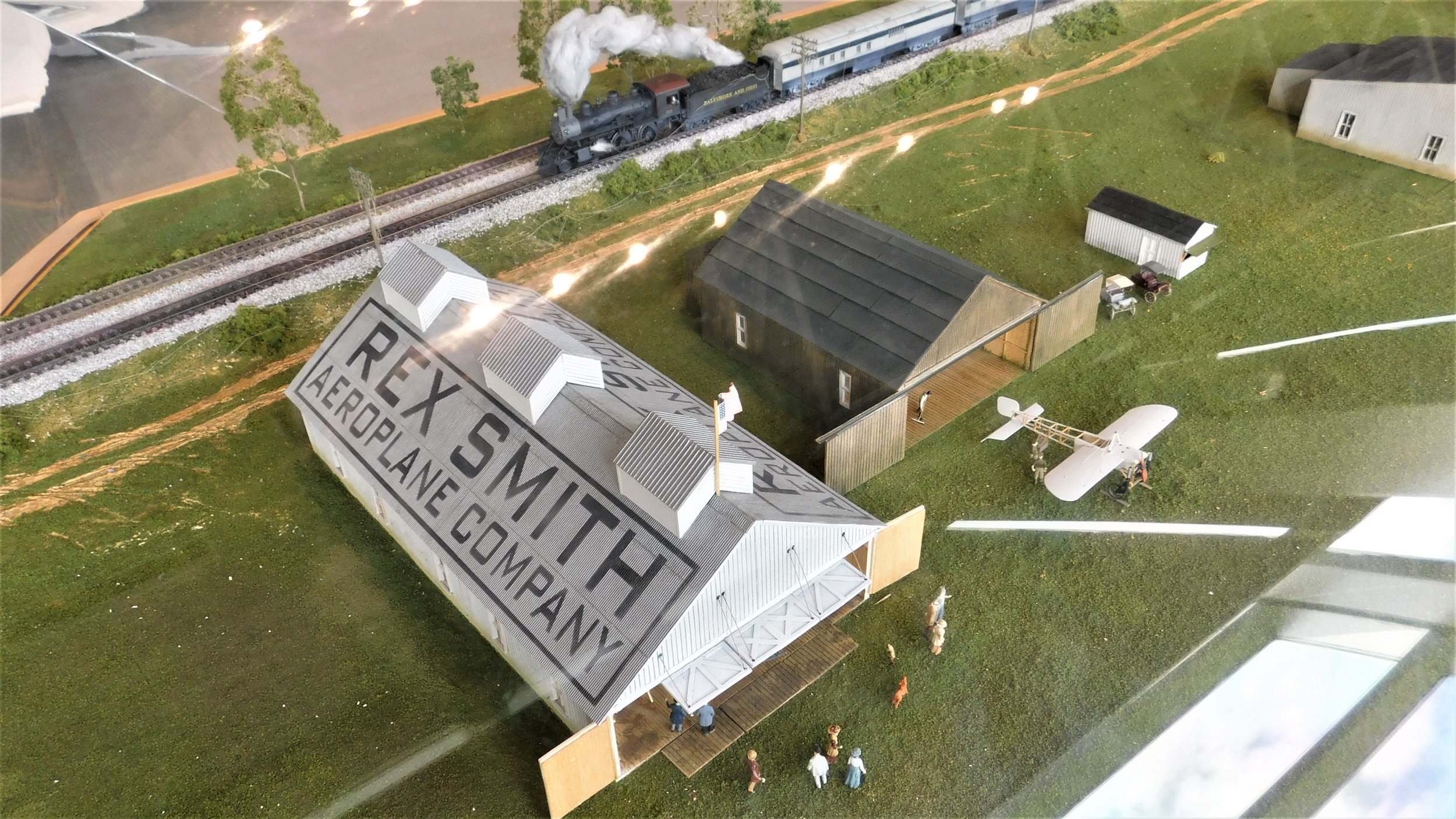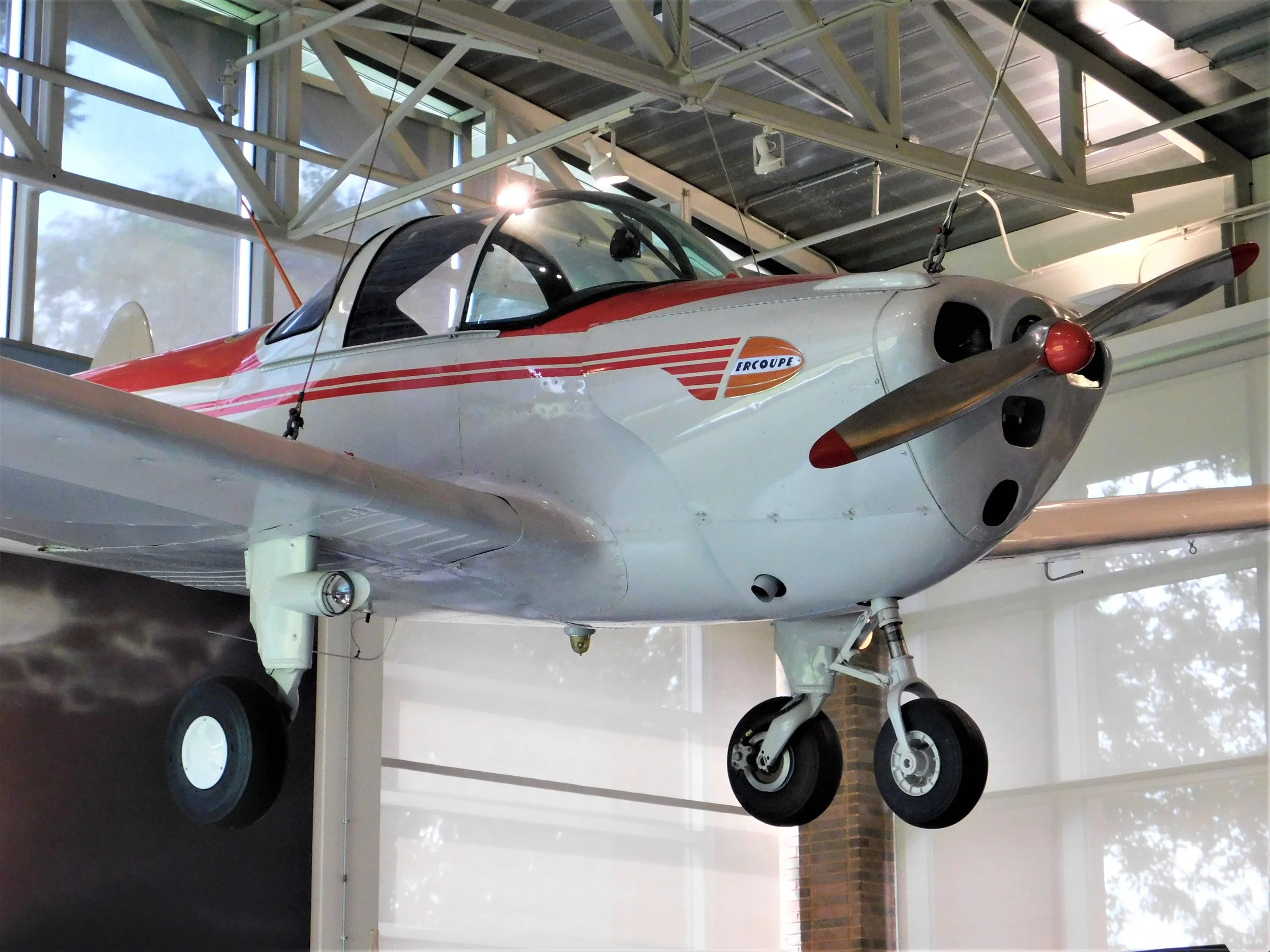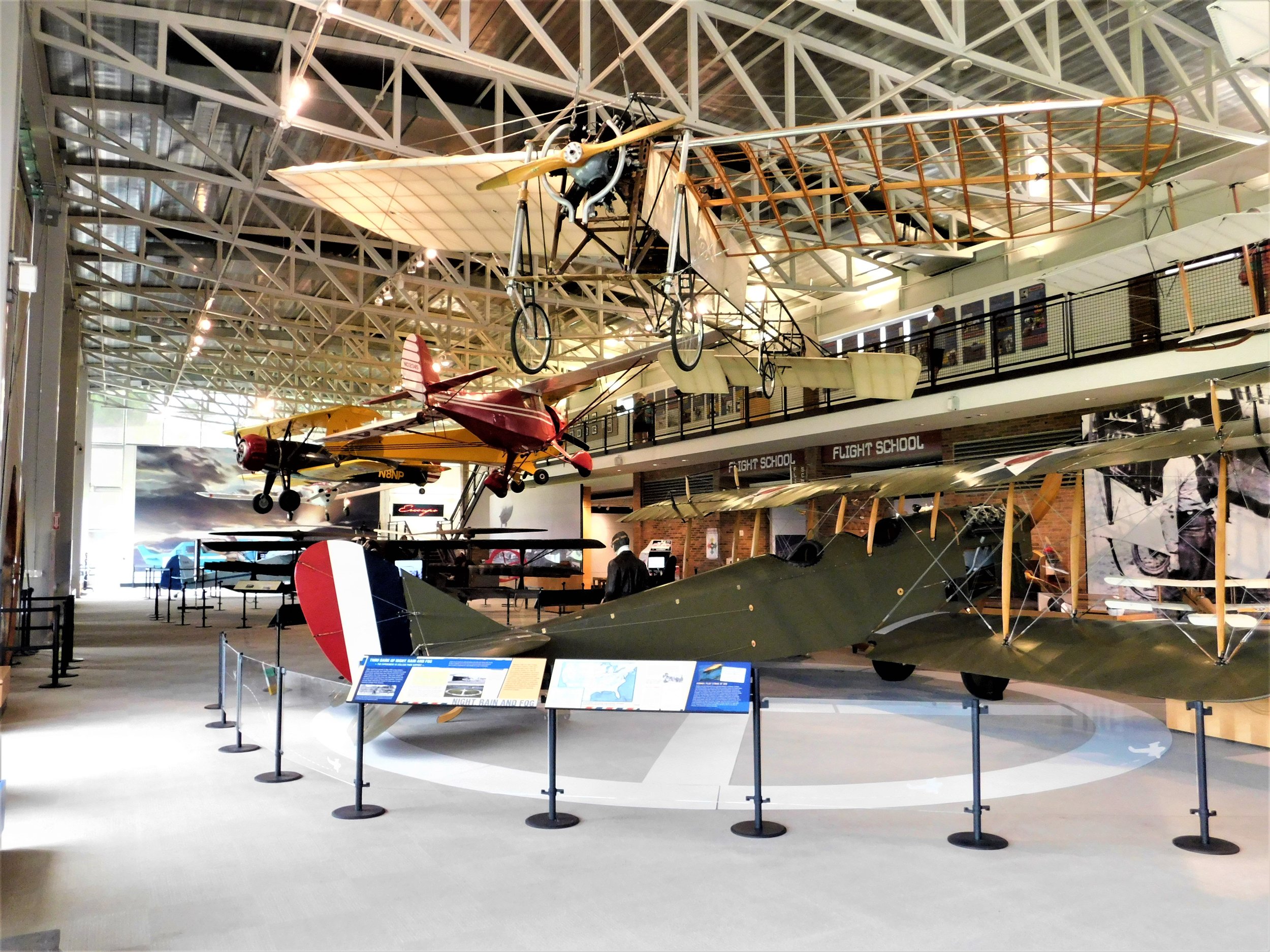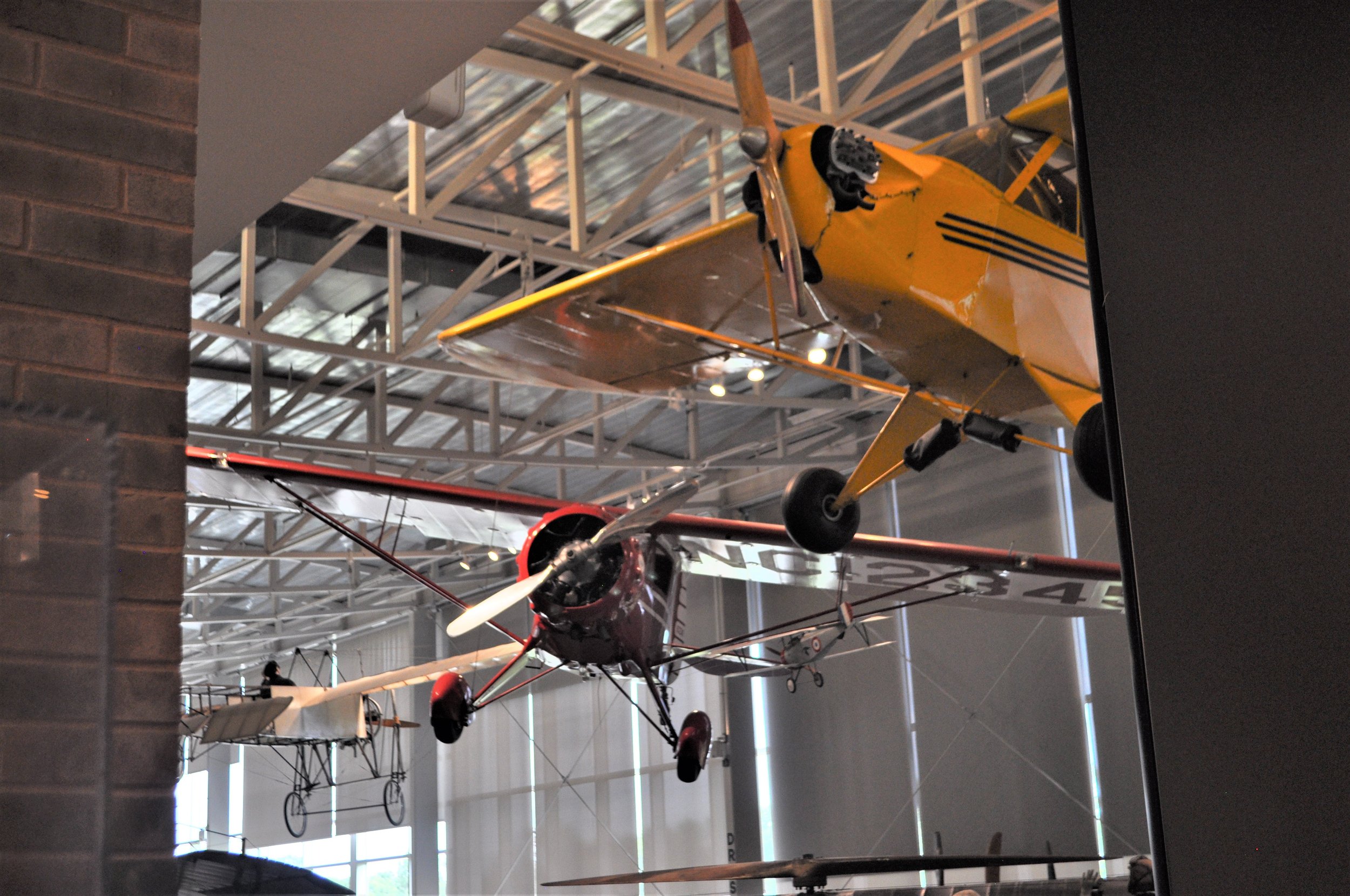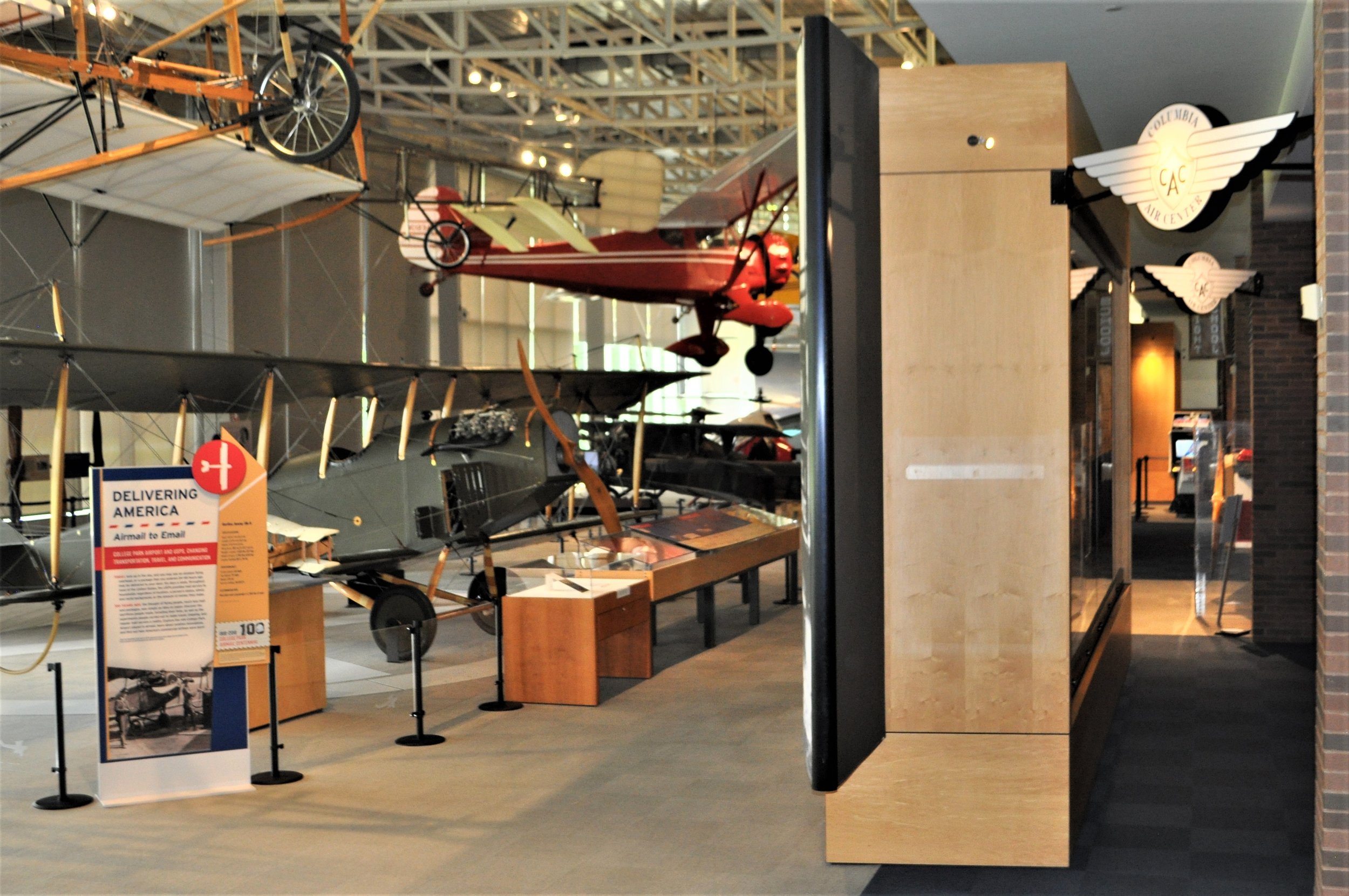College Park Aviation Museum
Issue 39 A visit to the College Park Aviation Museum in College Park MD
After their first powered flight in Kitty Hawk, on Dec 17 1903, the Wright brothers returned to Dayton and began work on improving their invention as well as looking for ways to sell it. They found an isolated field in nearby Huffman Prairie to continue their experiments. Keeping the flights away from press attention was still important to the brothers as they had not yet been granted a patent on their invention (that came in May of 1906). During 1904 and 1905 they made a number of flights, improving range and controllability. In 1906 and 1907, the Wright brothers did not fly at all. During this time, they concentrated on building aircraft that they could sell. They built approximately seven two-seater Model A aircraft in their workshop in Dayton, making it the first aircraft ever put into serial production. One of the aircraft was shipped to France to generate sales in Europe and number of Model As were built under license in France and Germany. In May of 1908 the brothers returned to Kitty Hawk to resume flight testing. This testing was successful and, in the fall of 1908, the Wrights demonstrated a modified version of their Model A for the U.S. Army during a competition at Fort Meyer, Virginia. They called this modified version of the Model A the Wright Military Flyer. In 1909, the Army picked the Wright’s plane to purchase and assigned the first plane to the Aeronautical Division of the U.S. Army Signal Corps. It was designated the Signal Corps (S.C.) No. 1.
Signal Corps (S.C.) No. 1
The contract with the Wrights included the training of two pilots. The demonstration area at Fort Meyer was too small to use for flight training and an alternate site was sought. A level area in College Park, near the Maryland Agricultural College (the University of Maryland today), was developed for this purpose. The location was somewhat isolated, and the fact that the B&O Railroad was nearby, made it an ideal location. Two Wright Model Bs were assigned to College Park and they were designated S.C. Number 3 and S.C. Number 4. On October 8 1909, Wilbur Wright began flight instruction for Lieutenants Frank Lahm and Frederic Humphreys.
Today there is a museum located on the College Park Airport and it contains a replica of the Wright Model B aircraft that was used for the first military flight training.
Note-
The names and designations that the Wrights used for their aircraft varied. Later historians have used sequential designations to help understand the chronology of the aircraft.
The original Military Flyer was donated to the Smithsonian in 1911. There is an original Model A on display in Berlin.
The two Model Bs were very similar in design to the Military Flyer, the main differences being that the elevator was moved to the rear of the aircraft and wheels were added to the skids.
The controls on the trainer, as originally designed, were opposite for each seat. The left seat pilot used his left hand to operate a lever for the elevator and his right hand operated a lever for the rudder and for wing warping. The right seat pilot used that same lever with his left hand and a third lever on his right controlled the elevator. This arrangement resulted in “left seat pilots” and “right seat pilots”; the control feel for these early pilots was quite different, depending on which seat they were in. Later models added a fourth lever so that each pilot had identical controls.
The reproduction of the Model B was built by Ken Hyde, who has built many replicas of Wright brothers’ planes for museums, including the National Air and Space Museum and the Wright Brothers Memorial on the Outer Banks.
—————————————————————
The College Park Aviation Museum was established in 1998. Although it is not large, it contains a number of notable aircraft and displays, and it does a great job of telling the story of the airport over the years. The airport at College Park is at the same location as the field that was established in 1909 and is the oldest continuously operated airport in the world.
Hanging above the Wright replica is a replica of the 1911 Glenn Curtiss Model D. The original was designated as Signal Corps No. 2. It was first assigned to Fort Sam Houston in Texas, where the Curtiss, flown by Lieutenant George Kelly, suffered a fatal crash. It was then rebuilt and shipped to College Park where it was again used for Army flight training.
In the early years, Glenn Curtiss was the main competitor to the Wright brothers. The brothers had approached Curtiss when they were searching for a lightweight engine for their original Wright Flyer (Curtiss was a well-known motorcycle builder and racer). It was after evaluating the Curtiss engine, as well as others, that the Wrights decided to build their own engine.
Curtiss went on to build his own planes, using an aileron system, rather than the wing-warping method that the Wrights used. This enabled Curtiss to get around paying the brothers royalties, but there were still a number of patent infringement law suits during this time.
Public domain photo
As you can see in this early photo, Curtiss mounted the ailerons between the wings. In other respects, The Model D followed the same convention as the Wright brothers – a pusher model with the elevator in front. There was a practical reason for the forward elevator for both Curtiss and the Wrights- it offered some protection to the pilot during the frequent crashes of the early models. By 1912, the elevators had been moved to the rear of the planes. In the case of Glenn Curtiss, this was called a Headless Pusher.
The Curtiss Model D helped establish the company’s relationship with the U.S. Navy when, in 1910, Eugene Ely took off from USS Birmingham in a Model D. This was the first time an aircraft had launched from a ship. In 1911, Ely made the first landing on a ship, the USS Pennsylvania, also in a Curtiss Model D.
A rare and unusual aircraft on display is this 1924 Berliner, which was tested here at College Park.
Emile Berliner was a German-American inventor best known for inventing the flat record for record players. About the time the Wright brothers came to College Park, he began working on developing a vertical takeoff and landing aircraft. In 1909 he formed the Gyro Motor Company. In 1910, he received a patent for a single rotor “gyrocopter”. After World War One, Emil’s son Henry took up the quest for vertical flight.
The 1924 plane that is on display was the most successful of the efforts of Emile and Henry. The basis of this model is a modified French Nieuport 23. After early trials, Berliner added a third wing to provide greater gliding capability in the event of a failure of the vertical lift. In February of 1924, the plane was demonstrated to Navy officials. It attained an altitude of 15 feet and was able to make turns within a 150-foot radius. These trials are considered to be the first controlled helicopter flight. By 1928, Berliner had given up on vertical flight and, along with Temple Joyce, formed the Berliner-Joyce Company. The most successful aircraft produced by the Berliner-Joyce company was the OJ-2, an observation seaplane for the U.S. Navy.
Representing the 1930s and the Golden Age of Aviation at College Park is this 1932 Monocoupe 110. Designed by Donald Luscombe, the name is derived from a combination of single wing (mono) and a car-like passenger compartment (coupe). It was this move away from open cockpits that helped widen the appeal of flying. The enclosed design also made aircraft faster and the Monocoupe 110 was popular with airshow pilots and speed racers. College Park was the site of a number of airshows during the 1920s and 30s. That time is known at the airport as The Brinkerhoff era. Airport manager George Brinkerhoff organized events with the Washington Air Derby Association, DC Air Legion, Washington Women's Pilots Association, and other aviation groups. Some of the best-known aviators of the day were seen at these events in College Park. Like similar events throughout the country, the events and the celebrities gave the public a measure of relief from the difficulties of the Great Depression.
1930s photo of NC12345 at the Long Island Aviation Country Club. Photo: Life photographer Alfred Eisenstaedt
This Monocoupe (NC 12345, serial no. 6W43) was originally owned by race pilot Peter Brooks, who used the plane to compete in the National Air Races.
At one end of the museum is a large HO scale model representing the early years of the aerodrome.
Rex Smith founded his aeroplane company at College Park in 1910 hoping to sell planes to the Army. In 1911, his biplane was used in successful tests of wireless communication for the Army Signal Corps. One of Smith’s pilots, Tony Jannus, was the first to fly more than one passenger on a flight (In 1914, Jannus became the first airline pilot, flying a scheduled flight from St. Petersburg to Tampa in a Benoist flying boat). Although his plane participated in a number of Army tests, Rex Smith was never able to make any sales to the Army. In 1916, the company went out of business and the hangar was then used for general aviation.
By 1912, the Army had moved its flight training school to San Diego, for year ‘round good weather, but College Park remained a center of aviation.
Based on a 1934 design by engineer Fred Weick for the National Advisory Committee for Aeronautics (NACA), the ERCO 310 first flew at College Park in 1937. The plane, which was quickly dubbed the Ercoupe, was designed to be easy and safe to fly. The Ercoupe has no rudder pedals- the rudders are linked to the yoke and move in combination with the ailerons. The Ercoupe was the first aircraft certified by the Civil Aeronautics Administration (CAA) as "characteristically incapable of spinning." The ERCO Ercoupe 415 went on sale in 1940 but only around 100 were sold before WW 2. A military version, which mainly used wood construction rather than aluminum, was produced during the war. That Ercoupe was used in the Army’s civilian flight training program, as well as by the Civil Air Patrol (CAP) for coastal patrol.
As soon as the war ended, the Ercoupe returned to civilian production (in nearby Riverdale, MD), with the hopes of capitalizing on a post-war flying boom. That boom did happen and, in 1946, over 4000 Ercoupes were manufactured. As has been noted before, the boom ended quickly and ERCO was sold in 1947. Designer Fred Wieck was later involved in the design of the Piper Cherokee.
A section of a second Ercoupe is on display, to give visitors a look at various parts of the plane, and how they work.
In July of 1909, Louis Blériot became the first person to cross the English Channel in a heavier-than-air craft. Flying a Blériot XI, he took off from Calais at dawn and made the crossing in 36 minutes, crash landing near Dover Castle. Blériot immediately became a world-wide celebrity as well as a very successful aircraft manufacturer. Between 1909 and the outbreak of WW 1, in 1914, Blériot sold almost 900 aircraft- most a variation of the Model XI. In 1912, the Moisant Company demonstrated the Blériot to the U.S. Army in College Park. The Army was reluctant to purchase a monoplane (Curtiss and the Wrights were still building bi-planes), and they did not purchase the Blériot. Not long after that, the National Aeroplane Company established operations at College Park Airport. The company became an authorized Blériot dealer, and a number of Blériot aircraft were based here .
This reproduction of the 1912 Blériot XI was built by the College Park Aviation Museum's restoration shop. Volunteers, led by restoration shop manager John Liebl, followed drawings that were published in 1912. The very accurate replica was completed in 2002.
We have seen many Stearmans in this series. The ubiquitous WW 2 trainer was used extensively for training and became an inexpensive war surplus plane after the war. This 1941 Boeing A75N1/PT-17 Stearman has an interesting, more recent, history. In April 2000, Gus McLeod flew this Stearman in an attempt to make the first open-cockpit flight over the North Pole. After 13 days, he accomplished his goal and circled the North Pole. On the return trip he had mechanical problems and was forced down on an ice floe. He returned to retrieve his plane a month later, only to find that it had drifted 80 miles away. With the help of the Air Force, the Navy, the New York Air National Guard, and the National Air and Space Museum, the plane was eventually returned to Maryland. McLeod flew a final flight in the Stearman at a College Park air show and then donated the historic plane to the museum.
Like the Stearman, the Curtiss JN-4 Jenny was widely used as a military trainer. In the case of the Jenny, it was WW 1 pilots who trained on her. And like the Stearman, the Jenny was widely used after the war for a variety of purposes.
This 1916 Curtiss JN-4D Jenny is an original aircraft. Its full history is unknown, as it was found in a number of pieces in San Antonio. It was restored by the Virginia Aviation and Machine company in Virginia. The restoration, which took over 12,000 man-hours, used about 60% of the original parts as well as some other original Curtiss parts. All parts that had to be fabricated were made from original specifications.
This excellent museum doesn’t stray from its mission of covering the history of aviation at College Park and it covers the Wright brothers and the beginnings of the airport especially well. There are a number of panels describing historic photographs as well as some interesting artefacts, such as this medal of Congress and Orville’s pocket watch.
There is also a re-creation of the Wright’s working and living space that they used here in 1909.
You can see that the Wright brothers maintained a simple existence, even after becoming world famous.
This is a great museum to visit. It is much more than a museum about the Wright brothers, but it does a great job of illustrating that lesser-known chapter in their history. A visit to the Nation’s Capital can easily include a trip out to College Park, and it is well worth the effort.
----------------------------------------
Many thanks to museum director Kevin Cabrera for his assistance in my research.
———————————————————————————
----------------------------------------
To learn about what to do in the local area, museum hours and costs as well as books to read and other interesting odds and ends, keep reading! At the end you will find a photo gallery of the entire museum.
PLANNING YOUR VISIT
Mondays Closed
Tuesdays-Sundays 10 am-4 pm
Closed on major holidays.
Admission
Adults: $5
Seniors: $4
Children: $2 (Free 1 and under)
FLYING IN
College Park Airport (KCGS) has a 2,607’ paved runway (15/33). RNAV approaches are available. The municipal airport has fuel and other services available. The FBO ramp is right next to the museum.
Note: In order to operate to/from College Park Airport, pilots must complete a multi-step vetting procedure. This process is required for all pilots wishing to fly into any of the three general aviation airports (CGS, VKX, W32) within the Washington Flight Restricted Zone. The procedure is here:
LOCAL ATTRACTIONS
The museum is just 10 miles from downtown Washington- and it is an easy addition to a trip to DC. There is, of course, another small aviation museum in DC that might be worth a visit.
The nearby University of Maryland was founded in 1856. The central area, McKeldin Mall, is surrounded by classic buildings and is a pleasant walk, especially in the summer. Be sure to rub the nose of “Testudo” the Terrapin, for luck.
WHERE TO EAT
Staff at the museum recommended nearby Hanami for Japanese food and Taqueria Habanero for Mexican food.
SUGGESTED READING
I have several times recommended books by historian Larry Tise. He is among my favorites of the many historians who have written about the Wright brothers. I recently finished one of his earlier works, Conquering the Sky. This book fits nicely with the period of the museum as it covers the Spring of 1908 flights the brothers made on the Outer Banks. These flights previewed the public demonstrations, later in 1908, in Washington DC and LeMans, France. The demonstrations led to sales to the U.S. Army and the founding of the College Park Airport. The flights in May of 1908 have not been written about a lot, but they were a very critical period in the development of the Wright brothers’ invention, and this book makes very interesting reading.
MUSEUM WEBSITE
https://www.mncppc.org/1593/College-Park-Aviation-Museum
UP NEXT
The American Airpower Museum, Farmingdale NY
MUSEUMS ARE WHERE YOU FIND THEM
This segment is dedicated to finding interesting aviation artifacts that are in public view- but not in an aviation museum. If you see one send a photo!
Governors Island sits off the southern end of Manhattan and it has a long history that goes back to the first Dutch settlers in the area and it is recognized as the birthplace of New York. Since those early years, Governors Island has been the site of a number of military encampments and there are still many former military buildings on the island. In the early 20th century, the Army began adding to the size of the island, using material excavated from the subway system being built in Manhattan. This work was completed by 1909 and the first use of the new space was as an airstrip. In October of 1909, Wilbur Wright flew from Governors Island over the west side of Manhattan and back. In 1910, Glenn Curtiss flew from Albany to Governors Island.
In 1954 an aviation preservation group, The Early Birds*, erected a memorial to early aviation events. This bronze prop was cast from an actual propeller that was on the 1909 Wright Military Flyer.
My son AJ, and daughter-in-law Angela, recently spent a couple of days on Governors Island, while AJ taught a seminar at Columbia. Thanks, Ange, for the photos!
*The Early Birds was founded in 1928 and the membership was limited to the 598 pioneering aviators who flew a balloon, glider, or plane prior to December 17th, 1916. The group was disbanded in 1998 when the last living member, George D. Grundy Jr., passed away. The organization was later reformed and is dedicated to collecting and publishing information about the original members.
————————————————————————————
PHOTO GALLERY
Click any photo to enlarge
Issue 39, Copyright©2022, Pilot House Publishing, LLC. All rights reserved. Except where noted, all photos by the author










